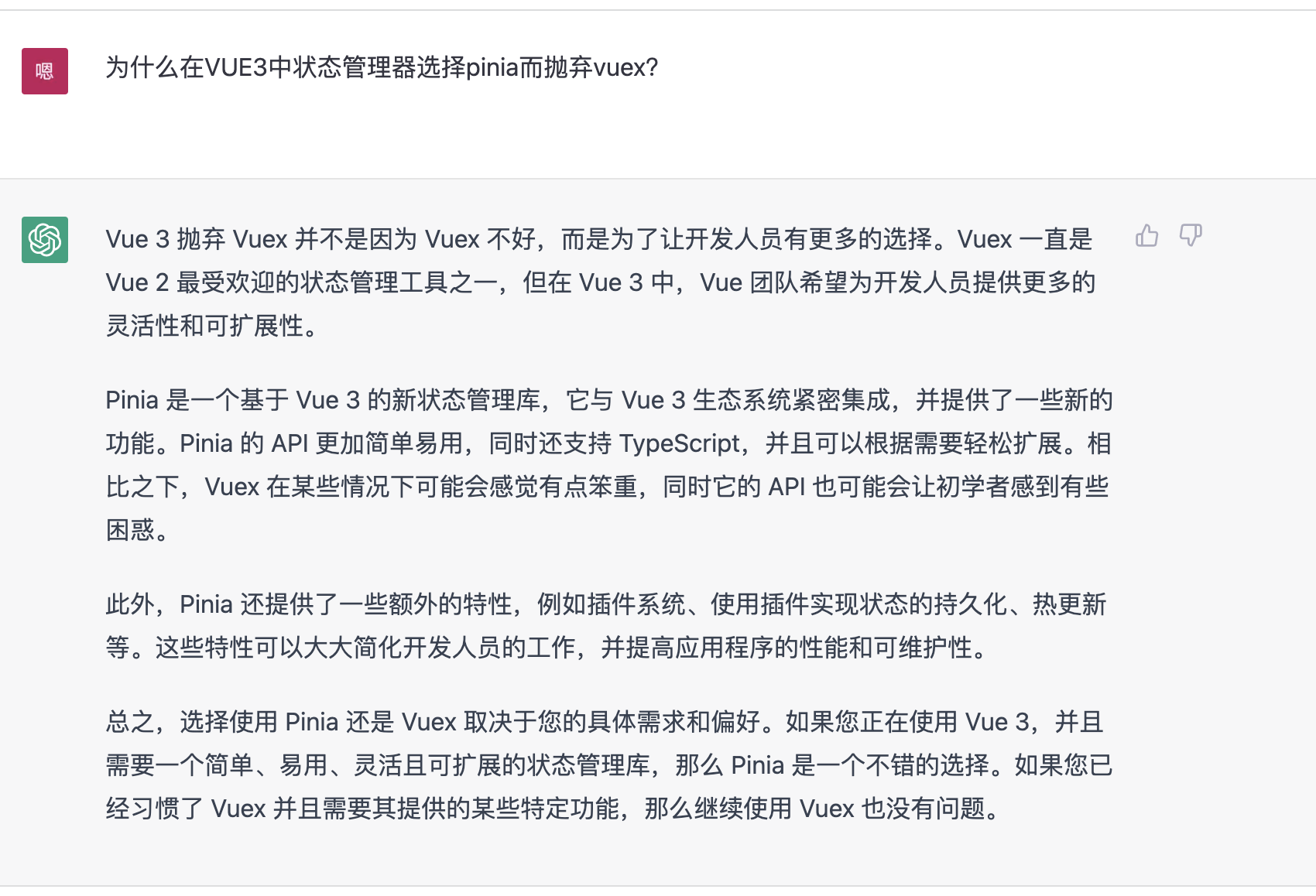对于pinia的使用,可参考官方文档在这不做过多赘述。这边主要来讲讲pinia中 少用且好用的方法,为什么我们选择pinia而不用vuex
ps: 以下写法全部基于组合式API
先下载依赖
npm i pinia -s
复制在vue3中,main.js这么写
import { createApp } from 'vue'
import { createPinia } from 'pinia'
import App from './App.vue'
const pinia = createPinia()
const app = createApp(App)
app.use(pinia)
app.mount('#app')
复制ps:就别考虑v2了吧,v2老老实实用vuex。
先看看chatGpt的回答🐶

but 这说了和没说一样
官方回答:
与 Vuex 相比,Pinia 不仅提供了一个更简单的 API,也提供了符合组合式 API 风格的 API,最重要的是,搭配 TypeScript 一起使用时有非常可靠的类型推断支持。
在传统的vuex中我们是不建议直接修改state的,而是建议我们通过mutation来修改state,但是在pinia中我们可以直接修改state。例如:
const store = useStore()
store.count++
复制如果我们需要在同一时间变更多个属性,可以通过$patch方法,例如:
store.$patch((state) => {
state.items.push({ name: 'shoes', quantity: 1 })
state.hasChanged = true
})
复制用来监听state是否发生变化,与watch相比,使用 $subscribe() 的好处是 subscriptions 在 patch 后只触发一次 。例如
cartStore.$subscribe((mutation, state) => {
// import { MutationType } from 'pinia'
mutation.type // 'direct' | 'patch object' | 'patch function'
// 和 cartStore.$id 一样
mutation.storeId // 'cart'
// 只有 mutation.type === 'patch object'的情况下才可用
mutation.payload // 传递给 cartStore.$patch() 的补丁对象。
// 每当状态发生变化时,将整个 state 持久化到本地存储。
localStorage.setItem('cart', JSON.stringify(state))
})
复制在组合式API中可以这么使用:
<script setup>
const someStore = useSomeStore()
// this subscription will be kept even after the component is unmounted
someStore.$subscribe(callback, { detached: true })
</script>
复制想要使用另一个 store 的 getter 的话,那就直接在 getter 内使用就好,例如:
import { useOtherStore } from './other-store'
export const useStore = defineStore('main', {
state: () => ({
// ...
}),
getters: {
otherGetter(state) {
const otherStore = useOtherStore()
return state.localData + otherStore.data //otherStore.data 就是其他getter中的getter
},
},
})
复制Getter 只是幕后的计算属性,所以不可以向它们传递任何参数。不过,你可以从 getter 返回一个函数,该函数可以接受任意参数,例如
export const useStore = defineStore('main', {
getters: {
getUserById: (state) => {
return (userId) => state.users.find((user) => user.id === userId)
},
},
})
复制组件中使用:
<script setup>
import { useUserListStore } from './store'
const userList = useUserListStore()
const { getUserById } = storeToRefs(userList)
// note you will have to use `getUserById.value` to access
// the function within the <script setup>
</script>
<template>
<p>User 2: {{ getUserById(2) }}</p>
</template>
复制ps: getter 将不再被缓存,它们只是一个被你调用的函数。不过,你可以在 getter 本身中缓存一些结果,虽然这种做法并不常见,但有证明表明它的性能会更好
举个🌰:
import { useAuthStore } from './auth-store'
export const useSettingsStore = defineStore('settings', {
state: () => ({
preferences: null,
// ...
}),
actions: {
async fetchUserPreferences() {
const auth = useAuthStore()
if (auth.isAuthenticated) {
this.preferences = await fetchPreferences() //这行用了别的store的action
} else {
throw new Error('User must be authenticated')
}
},
},
})
复制你可以通过 store.$onAction() 来监听 action 和它们的结果。传递给它的回调函数会在 action 本身之前执行。after 表示在 promise 解决之后,允许你在 action 解决后执行一个一个回调函数。同样地,onError 允许你在 action 抛出错误或 reject 时执行一个回调函数。这些函数对于追踪运行时错误非常有用,类似于Vue docs 中的这个提示。
这里有一个例子,在运行 action 之前以及 action resolve/reject 之后打印日志记录。
const unsubscribe = someStore.$onAction(
({
name, // action 名称
store, // store 实例,类似 `someStore`
args, // 传递给 action 的参数数组
after, // 在 action 返回或解决后的钩子
onError, // action 抛出或拒绝的钩子
}) => {
// 为这个特定的 action 调用提供一个共享变量
const startTime = Date.now()
// 这将在执行 "store "的 action 之前触发。
console.log(`Start "${name}" with params [${args.join(', ')}].`)
// 这将在 action 成功并完全运行后触发。
// 它等待着任何返回的 promise
after((result) => {
console.log(
`Finished "${name}" after ${
Date.now() - startTime
}ms.\nResult: ${result}.`
)
})
// 如果 action 抛出或返回一个拒绝的 promise,这将触发
onError((error) => {
console.warn(
`Failed "${name}" after ${Date.now() - startTime}ms.\nError: ${error}.`
)
})
}
)
// 手动删除监听器
unsubscribe()
复制默认情况下,action 订阅器会被绑定到添加它们的组件上(如果 store 在组件的 setup() 内)。这意味着,当该组件被卸载时,它们将被自动删除。如果你想在组件卸载后依旧保留它们,请将 true 作为第二个参数传递给 action 订阅器,以便将其从当前组件中分离:
<script setup>
const someStore = useSomeStore()
// this subscription will be kept even after the component is unmounted
someStore.$onAction(callback, true)
</script>
复制ps:这部分没有亲自写过demo,直接照搬官方文档了
由于有了底层 API 的支持,Pinia store 现在完全支持扩展。以下是你可以扩展的内容:
import { createPinia } from 'pinia'
// 创建的每个 store 中都会添加一个名为 `secret` 的属性。
// 在安装此插件后,插件可以保存在不同的文件中
function SecretPiniaPlugin() {
return { secret: 'the cake is a lie' }
}
const pinia = createPinia()
// 将该插件交给 Pinia
pinia.use(SecretPiniaPlugin)
// 在另一个文件中
const store = useStore()
store.secret // 'the cake is a lie'
复制这对添加全局对象很有用,如路由器、modal 或 toast 管理器。
为了能让devtools 自动追踪到,推荐使用下列方法:
pinia.use(({ store }) => {
store.hello = 'world'
})
复制const sharedRef = ref('shared')
pinia.use(({ store }) => {
// 每个 store 都有单独的 `hello` 属性
store.hello = ref('secret')
// 它会被自动解包
store.hello // 'secret'
// 所有的 store 都在共享 `shared` 属性的值
store.shared = sharedRef
store.shared // 'shared'
})
复制在定义 store 时,可以创建新的选项,以便在插件中使用它们。例如,你可以创建一个 debounce 选项,允许你让任何 action 实现防抖。
defineStore('search', {
actions: {
searchContacts() {
// ...
},
},
// 这将在后面被一个插件读取
debounce: {
// 让 action searchContacts 防抖 300ms
searchContacts: 300,
},
})
复制然后,该插件可以读取该选项来包装 action,并替换原始 action:
// 使用任意防抖库
import debounce from 'lodash/debounce'
pinia.use(({ options, store }) => {
if (options.debounce) {
// 我们正在用新的 action 来覆盖这些 action
return Object.keys(options.debounce).reduce((debouncedActions, action) => {
debouncedActions[action] = debounce(
store[action],
options.debounce[action]
)
return debouncedActions
}, {})
}
})
复制注意,在使用 setup 语法时,自定义选项作为第 3 个参数传递:(前面举的例子都是 Option Store)
defineStore(
'search',
() => {
// ...
},
{
// 这将在后面被一个插件读取
debounce: {
// 让 action searchContacts 防抖 300ms
searchContacts: 300,
},
}
)
复制以下均为亲自写过demo,以后再补充吧